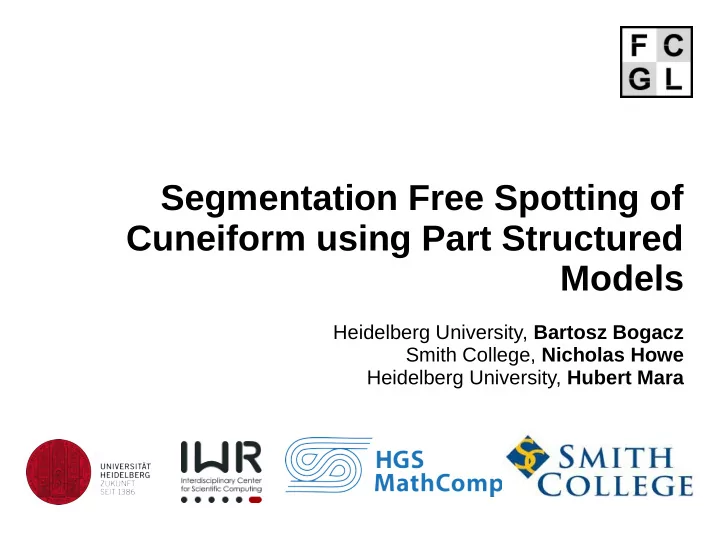

Segmentation Free Spotting of Cuneiform using Part Structured Models Heidelberg University, Bartosz Bogacz Smith College, Nicholas Howe Heidelberg University, Hubert Mara
Cuneiform Script ● More than 3,000 years of history ● Evolved from a pictographic to a syllabic script c ● More than 500,000 clay tablets ● Only few Assyriologists
Cuneiform Script ● Cuneiform is a writing system used by at least 7 different languages ● Written by impressing a rectangular stylus in wet clay ● Our approach models geometric patterns instead of language
Goal ● Only few tablets are transliterated ● Transliterations can be incomplete and subjective ● Provide a mechanism for searching by graphical query
Different Sources 3D Scans Retro-digitized Born-digital Unification of sources requires a common geometrical representation
Extracting Wedges ● We model wedges as triangles with arms ● Find possible candidate wedges by finding cycles ● Prune this set of candidates using modeling constraints – No overlapping wedges – Sizes and angles are within sane bounds – Prioritize bigger wedges
Extracting Wedges ● We re-formulate this constraint satisfaction task as an optimizing assignment task ● This enables us an efficient O(n^3) solution ● The set of strokes is being assigned to a set of candidate wedges
Optimal Assignment
Optimal Assignment
Optimal Assignment
Optimal Assignment
Wedge Features ● We want to represent extracted wedges as feature vectors ● Intersections and endpoints are most salient points in wedges ● Model wedges using these keypoints
Keypoint Model ● Feature vector is a concatenation of the keypoints in our wedge model – Wedge-head intersections – Wedge-arm endpoints
Keypoint Model ● Features are compared by Euclidean distance ● Our new approach reorders points using optimal assignment
Part-structured Spotting • Model characters as wedges connected by tree of fmexible links • Align query to candidates by deforming links • Probability of a match is wedge similarities plus amount of link deformation
Generalized Distance Transform GDT Query T arget • Trades ofg between wedge similarity and distance
Part Structured Match Demo Query T arget
Part Structured Match Demo Query T arget
Part Structured Match Demo Query T arget
Part Structured Match Demo Query T arget
Part Structured Match Demo Query T arget
Part Structured Match Demo Query T arget
Part Structured Match Demo Query T arget
Sample Results
Evaluation ● Symbol spotting task with 40 query symbols of various lengths ● We compare against Rothacker et al. HMM Latin word spotting – No elevation data to evaluate their approach for cuneiform spotting – We rasterize our data to make it available for their method
Evaluation ● Dataset are two cuneiform tablets with 500 identifiable characters ● Tablets are only incompletely labeled, precluding an automated evaluation ● Retrieval results are checked by an expert for false positives
Evaluation
Query Results
Summary ● Fast and optimizing method for cuneiform wedge detection ● Native and accurate feature representation of cuneiform wedges ● Fast symbol spotting of cuneiform characters
Part-Structured Spotting vs. T emplate Matching Query T arget Part-structured: T emplate: Approximate match Matches only part everywhere
Recommend
More recommend